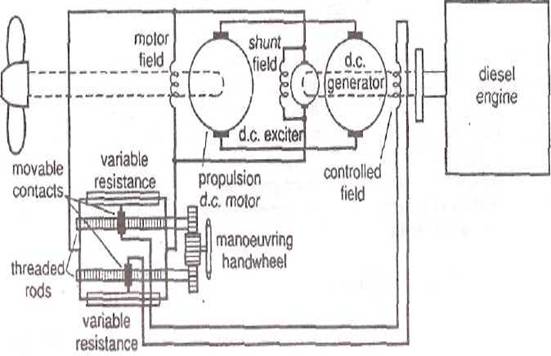Question
Diesel electric propulsion, is now being chosen
as the power plant for an increasingly wide variety of vessels.
Sketch a simple layout of such an installation.
Explain the advantages of selecting such a plant.

Simple
Ward-Leonard system for diesel-eieciric propulsion
The simple
Ward-Leonard arrangement for diesel electric propulsion (Figure.) is an all-d.c. scheme with a diesel engine as the prime mover driving
the single
An exciter
mounted on an extension of the generator shaft provides field current both for
the generator and for the direct current propulsion motor.
The exciter
is itself a
At
start-up, the armature windings of the exciter have current generated in them
when they pass through the field emanating from the residual magnetism of the
exciter poles.
The small
current generated initially, circulates through the windings of the exciter
poles, strengthening their magnetic fields until full output is reached.
The current
generated in the
It is
available to the field poles of the generator, but only through the regulating
resistances of the manoeuvring control.
If the
control contacts are at the raid positions of the resistances, then no current
flows to the main generator poles and there is no output from it to the
propulsion motor.
Rotation of
the manoeuvring handwheel and gears turns the
threaded bars to move the contacts along the resistances, in opposite directions.
As the
contacts travel toward the extremities and resistance lessens, current from the
exciter flows to the generator field poles.
The
direction of current flow and the level are used to control the output of the
generator and, in turn, the propulsion motor. Propeller speed is proportional
to the actual voltage produced in the generator and fed to the propulsion
motor.
The
advantages claimed for electrical transmission for main propulsion are :—
Reliability
in so far as a number of small generating sets can be used, should one or
more of the sets require attention or should break down take place, the ship
could still be run at slightly reduced speed until repairs were effected.
Economy.
The whole
power can be transmitted through one propeller running at its most economical
revolutions reducing the losses due to cavitation
also losses due to friction of extra bossing and brackets where multiple screws
are fitted.
The
electrical transmission is as efficient at half-load as at full load, as the
main generator prime movers are running at a constant speed and do not need to
be reversed when ship has to go astern.
A uniform
torque is maintained at all loads, thus eliminating the variable twisting
stresses obtained in reciprocating direct coupled prime movers.
Intermediate
shafting can be dispensed with as the motor on propeller shaft can be placed
well aft and the current led to it, thus allowing more room for cargo.
The
generating sets can be placed in any convenient position in the ship and not
especially in line with the propeller shafting. The same power is available for
going astern as for going ahead.
No reverse
turbine required.
Ease
of Control.
Manoeuvring
is very much simplified as shopping, reversing or slowing down can be done by
one switch.
Low
noise.
An electric
motor is able to provide a drive with very low vibration characteristic and
this is of importance in ocengraphic survey vessel
and cruise ships where for different reasons a low noise signature is
required.
Auxiliary
Power.
Since the
main generating sets can be made small, all or any may be used in port for
lighting, working winches, or cooling chambers.